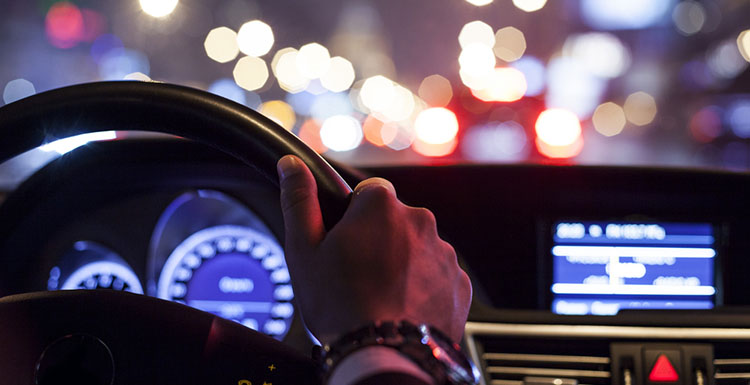As the days get shorter and we head into another Kansas City winter, we spend a lot more time driving at night. It’s unavoidable when the sun sets by 5 pm! Unfortunately, however, nighttime is the most dangerous time to find yourself behind the wheel – particularly if you have any vision issues.
Did you know that depth perception, color recognition and even peripheral vision can be compromised at night? Worse still, headlights from oncoming traffic can even blind a driver, if only temporarily. And as we all know, it only takes a split second for a traffic accident to happen – less than the blink of an eye! Any vision issue, even if only temporary, can be deadly. That’s why it’s so important to take extra care when driving at night.
In the dark, your reaction time is minimized. Even with the brightest LED headlights, the street is only illuminated 150-250 feet, leaving you less time to identify and react to a problem up ahead. Combine that with high rates of speed and impaired vision, and it can be a recipe for disaster.

Why is Vision Impaired at Night?
For most people, vision deteriorates with age. Just because you may have 20/20 vision in your teens, does not mean you’ll have perfect eyesight in your forties. Cataracts, various eye conditions or diseases, and a host of other factors all contribute to compromised eyesight over time. And with respect to night driving, older adults simply need more light to see clearly – regardless of vision clarity. Put simply, the darker it is, the harder it is to see, plan, and react accordingly.
Other Factors to Consider:
Despite the best plans, we can’t always control a situation. Take rush hour, for example. With so many people on the road at once, all eager to get home at the same time, driving can be particularly dangerous – especially in the winter months when it gets dark so early.
Distracted and impaired drivers are also wildcards. You can never know when the driver next to you will suddenly swerve into your lane, or plow into the back of your vehicle at a red light. Even with perfect eyesight, you can’t prevent other drivers from causing mayhem.
These, along with other factors, explain why 49% of traffic fatalities occur at night. Please be careful!
Can I Wear Night Driving Glasses?
It’s a common misconception that wearing yellow tinted night driving glasses will help you see better in the dark. The problem is that the tint appears to improve contrast, leaving the impression that the wearer can see more clearly. This is not true. ANY tint reduces the amount of light transmitted to the eye, further reducing visibility for the driver.
“Yellow ‘Night Driving’ lenses have been shown to provide no benefit in seeing ability at night. They are even hazardous, because they give the driver a feeling of seeing better, which no one has yet been able to explain. Studies have shown that they actually impair visual performance and retard glare recovery.” – Forensic Aspects of Vision and Highway Safety”, Merrill J. Allen, O.D., Ph.D., Et al.”
If headlight glare is a problem, or if you experience “night blindness,” you should schedule an appointment with your ophthalmologist. The bright lights may not be to blame. Only with a comprehensive eye exam can your doctor identify medical conditions or developing cataracts impairing your vision.
Preventing Night Driving Accidents
Thankfully, there are a few steps you can take to reduce the likelihood of a vision-related traffic accident.
1. Plan ahead. If you can, try to schedule your appointments and travel plans during the day time. While we can’t always fit our daily schedules into daylight hours, rearranging a few errands to reduce your time spent driving at night will certainly help.
2. Get your eyes checked for more than simple vision issues! A comprehensive eye exam will identify eye diseases and conditions that may reduce your vision in the dark.
3. Get plenty of rest. Tired eyes aren’t ever helpful no matter what the driving conditions.
4. Stay alert and minimize distractions. If your eyes are on your phone, they’re not on the road ahead of you, and that’s a huge problem.
5. NEVER DRINK AND DRIVE!
Whatever the condition of your eyes, or the clarity of your vision, it’s important to always be cautious when driving at night. Many factors beyond the health of your eyes play a role in keeping your safe, and not all of them are within your control. Night driving is always dangerous, so please be careful!
Posted November 30, 2017 by Silverstein Eye Centers